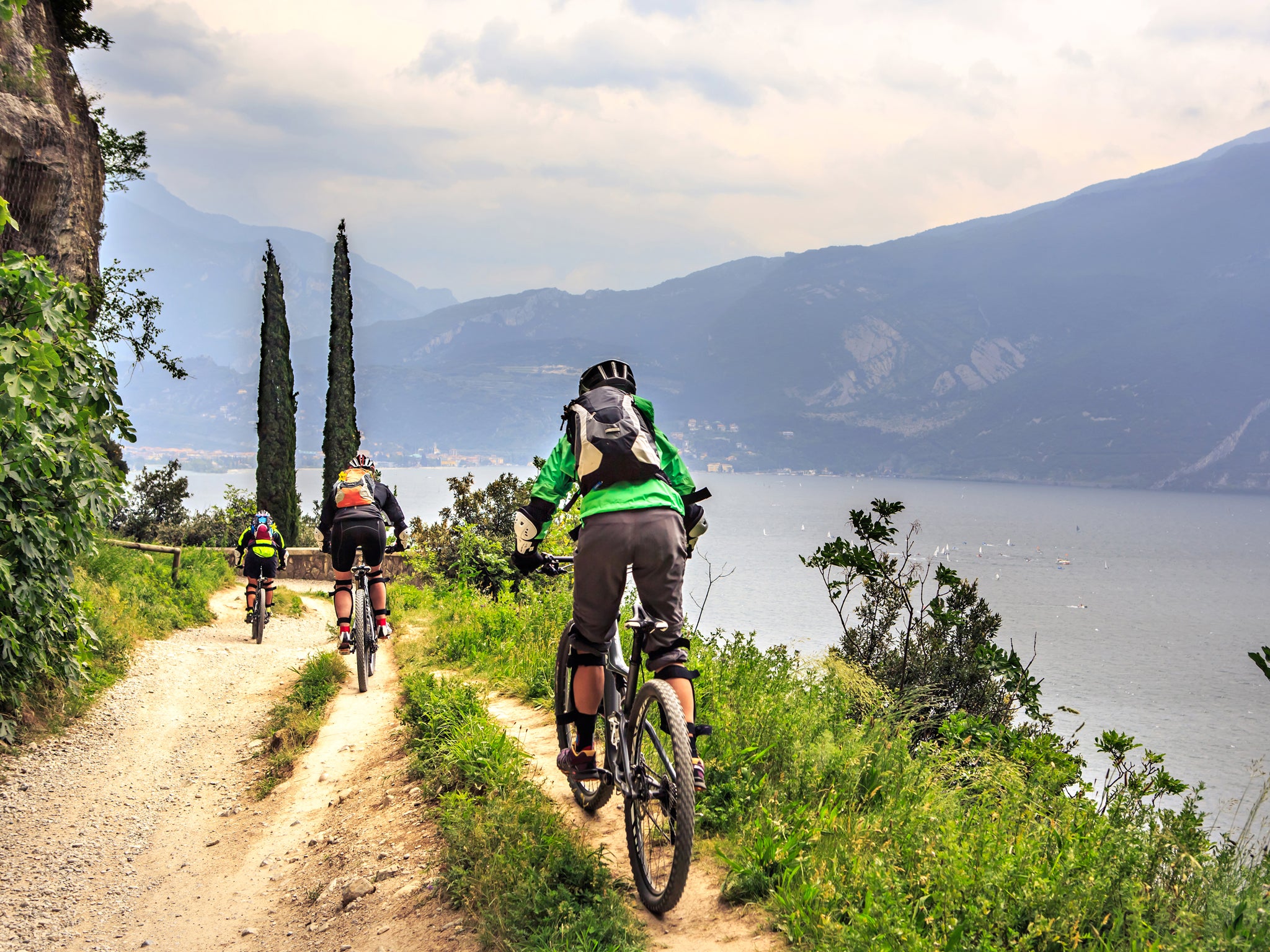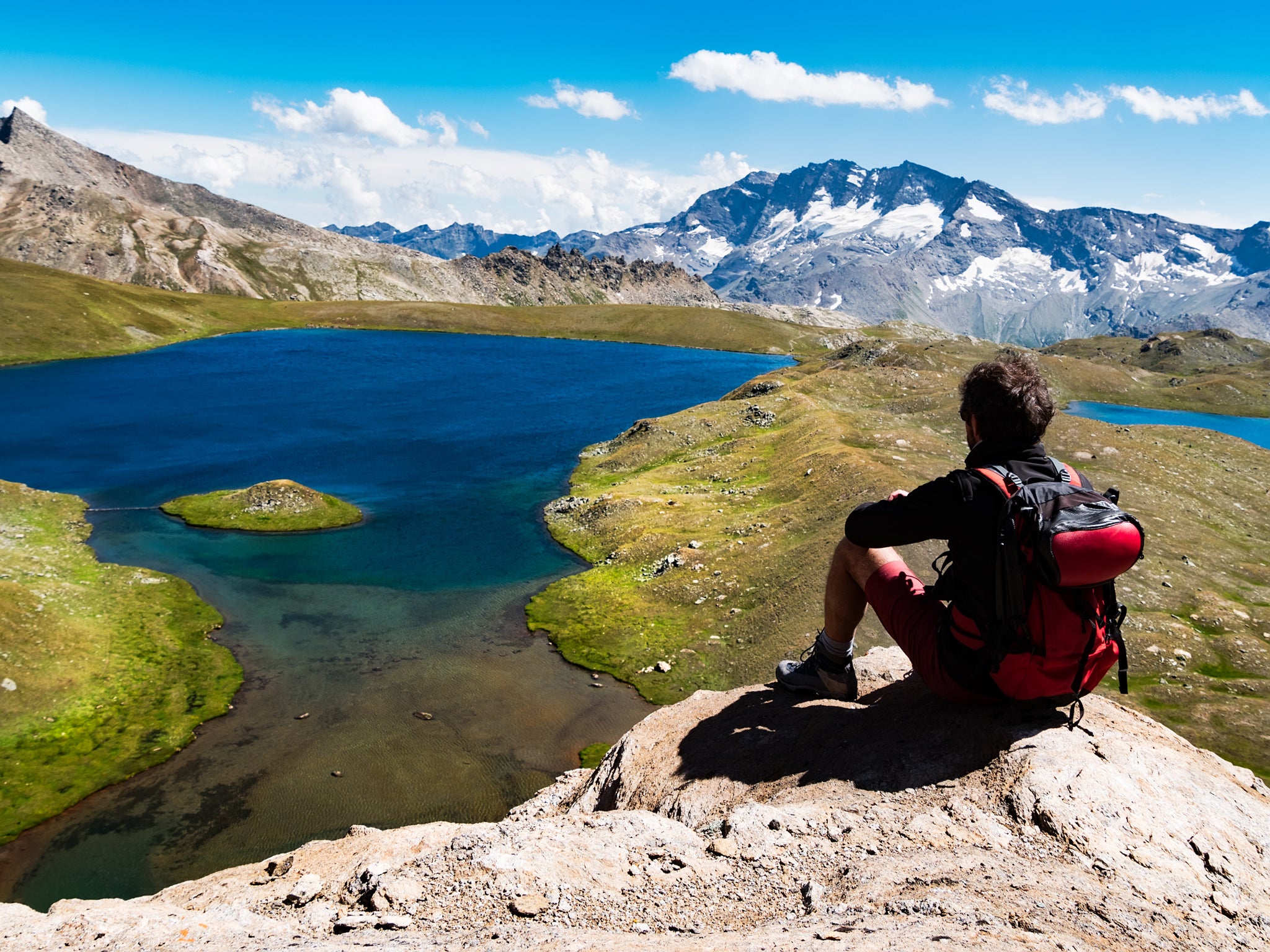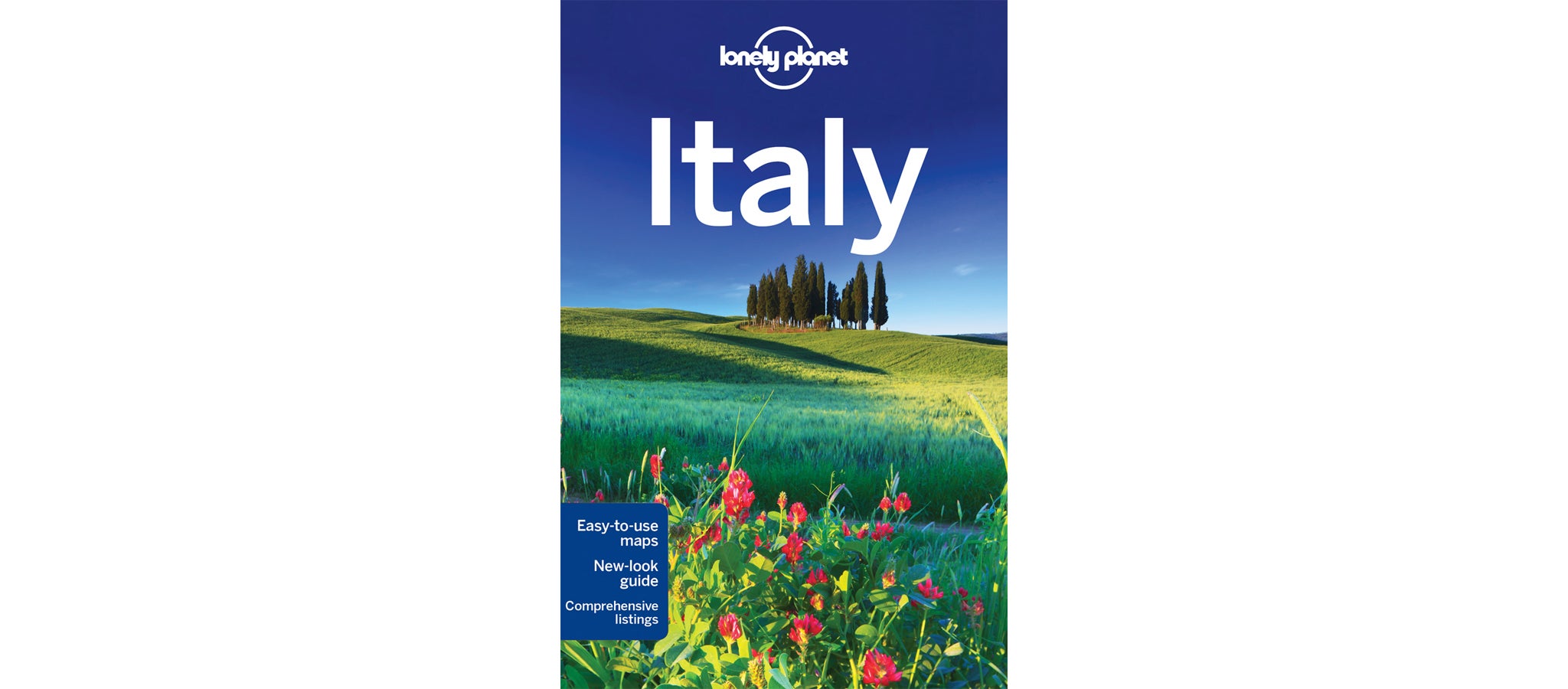The Independent's journalism is supported by our readers. When you purchase through links on our site, we may earn commission.
Travel guide to... Active holidays in Italy
In the second of our three-part Italy series, produced in association with Lonely Planet, Kerry Christiani selects the best ways to explore the spectacular landscape, from hiking and biking to windsurfing and white water rafting

Your support helps us to tell the story
From reproductive rights to climate change to Big Tech, The Independent is on the ground when the story is developing. Whether it's investigating the financials of Elon Musk's pro-Trump PAC or producing our latest documentary, 'The A Word', which shines a light on the American women fighting for reproductive rights, we know how important it is to parse out the facts from the messaging.
At such a critical moment in US history, we need reporters on the ground. Your donation allows us to keep sending journalists to speak to both sides of the story.
The Independent is trusted by Americans across the entire political spectrum. And unlike many other quality news outlets, we choose not to lock Americans out of our reporting and analysis with paywalls. We believe quality journalism should be available to everyone, paid for by those who can afford it.
Your support makes all the difference.Strike out into Italy’s wilderness and it becomes clear that the country’s appeal extends way beyond Renaissance art and plates of pasta. Mother Nature had one of her finest moments here: from the snow-frosted Alps in the north to Tuscany’s shaggy olive groves, where cicadas drone at dusk, and the south’s volcanic craters and grottoes shimmering opalescent in the heat haze.
From the top to the high heel of Italy, there are plenty of ways to enjoy the outdoors. The Alps, skirting the northwest, are among Europe’s tallest and sunniest, with the bonus of family-run trattorias for post-ski feasts after a morning on the slopes. Rippling northeast are the Dolomites, with grey-stone turrets rising like natural fortifications.
Edge south and there is something almost lyrical about the way the landscapes unfold - hills feathered with cypresses, medieval towns of honeyed stone, vineyards dappled with white sunlight, and olive-tangled promontories jutting into smooth seas of sapphire and jade. Italy is a thing of beauty, whether you’re cycling through Tuscan vineyards, wine-tasting as you pedal, witnessing the springtime eruption of wildflowers in the Apennines, or watching Stromboli’s volcanic fireworks while hiking on the Aeolian Islands.
While the population of 60 million gives the cities an eternal buzz, the crowds soon thin in Italy’s wild places; on remote trails threading to hidden coves, distant mountaintops or truffle-rich forests with barely a soul in sight. The best bet for seclusion is one of the country’s 24 national parks. These, together with 145 regional parks, 30 marine protected areas and 147 nature reserves, are listed on the National Parks (parks.it) trip-planning website.
Crisscrossing the country are thousands of kilometres of sentieri (marked trails), which immerse you in the Italy the brochures forgot to mention. Walks reach from coastal strolls around the pastel-painted cliffhanger villages of Cinque Terre to multi-day hikes amid the Alps’ snow-capped four-thousanders, and the epic Alte Vie that wriggle across the Unesco-listed rock spires of the Dolomites.
Long-distance hikes can easily be divided into manageable chunks with stays at rifugi, charmingly rustic huts offering basic digs with a view and home-cooked grub to walkers. Many of Italy’s rifugi, which total 774, are managed by the Club Alpino Italiano (cai.it) and are searchable using its interactive map. It’s advisable to book well ahead in the summer months when beds fill up in a flash.
With a little pre-planning, some experience under your belt and a decent map, you can go it alone. Tabacco (tabaccoeditrice.com) publishes a great series of hiking and cycling maps.
If time is an issue, you might get more out of a guided hiking or cycling break. Explore (explore.co.uk) has recently launched two new trips: an eight-day, moderate graded cycling trip through foodie Emilia Romagna, with prices starting at £949pp including tastings and flights, and an eight-day Taste of Puglia walk from £1,099pp including flights.
Headwater (headwater.com) has a seven-night self-guided walk in the Dolomites from £999pp including half board, route notes and maps, flights and transfers. Keen cyclists might prefer their eight-night self-guided spin of Assisi in Umbria, costing from £1,259pp including half board, bike hire and luggage transfers.
In terms of when to go, it’s best to avoid August, when the Italians are on holiday, increasing the crowds on the coast and trails tenfold. Rifugi in the Dolomites and Alps open in summer only – June and September are ideal for dodging the masses and snagging a bed. That rule of thumb stands for the rest of Italy, too - hiking and cycling are best in spring and early autumn, when temperatures are mild and the countryside is at its most colourful.
Walking
Italy really is a boot made for walking. Going north to south, you could begin with the Dolomites. The half-day Tre Cime di Lavaredo hike is like an espresso shot of the region, with exhilarating climbs and pop-up views of a trio of peaks shaped like bishops’ mitres. Cicerone’s Trekking in the Dolomites guidebook (cicerone.co.uk) gives you the heads-up on the high-altitude, multi-day Alta Via routes 1 and 2, taking in the most spectacular bits of the Dolomites.
Cherry-picking the Italian Alps for walks is tough, but we have to hand it to Gran Paradiso (pngp.it). Spreading between Aosta Valley and Piedmont, the country’s oldest, most famous national park has a pinch of everything: glaciers, jewel-coloured lakes, forests, an eponymous 4061m peak and a healthy ibex population – best glimpsed on 724km of trails and mule tracks.

Let’s not forget the coast. Among the classics are Cinque Terre’s 12km Sentiero Azzurro (Blue Trail, marked No 2 on maps), teetering past vines, olive groves and five preposterously perched fishing villages in ice-cream hues.
Further south, Amalfi’s half-day Sentiero degli Dei follows an elevated mule trail to unveil terraced mountains, lemon orchards and fragrant macchia swooping down to the Mediterranean.
The Holy Grail for serious (and seriously fit) hikers, however, is Sardinia’s 45km, week-long Selvaggio Blu (selvaggioblu.it). Hailed as Italy’s toughest trek, it’s an epic, off-the-radar coastal romp, involving grade IV+ climbs. Some guidance is essential; try climbing pro Corrado Conca (corradoconca.it), who covers the hike in seven days for €600 including transport, food and drink. Outdoor experts Peter and Anne at the Lemon House (peteranne.it) offer logistical support to their guests, with transport, water provided en route, phone support and the loan of a GPS from €40 per person, minimum €130.
Cycling
No region has been more romanticised than Tuscany, where you can pedal over hill and olive-draped dale, ticking off higgledy-piggledy medieval hamlets. Chianti, south of Florence, remains a favourite, and locally based I Bike Tuscany (ibiketuscany.com) arranges single, multi-day and custom trips, including e-bike tours. Single day tours start at €90-150 and include guides, water, hotel pick-ups/drop-offs and sometimes lunch.
In Umbria, the Valnerina and wildflower-freckled Piano Grande are laced with quiet trails. Swinging north, Emilia-Romagna and Barolo’s terraced vineyards are ideal for low-key bike touring, with abundant food and wine breaking things up. Or to pedal through a scene straight out of a Canaletto, try Veneto’s Brento Riviera, where 150km of bike routes weave past stately Venetian villas.
In summer, the Alps hum with cyclists. Mountain bikers tear around Lakes Garda and Maggiore, and the Dolomites in Trentino Alto-Adige. Sardinia’s east coast, where the mountains of the Supramonte sheer down to the Golfo di Orosei, is equally challenging. Bikes are widely available for hire in most towns and resorts.
Diving
Italy has 7,600km of coastline, and spending time on la spiaggia (the beach) is a national obsession, but water-based activities enticing you away from the sun-lounger abound.
Diving is big, with hundreds of schools offering Padi courses for all levels and equipment hire; most open seasonally from June to October. The Cinque Terre Marine Reserve (cinqueterre.com), Capri, Ischia and Procida in the Bay of Naples, the Parco Nazionale Arcipelago Toscano (islepark.it), and Campania’s Punta Campanella, where marine life splashes around underwater grottoes and ancient ruins, are all great places to take the plunge.
Sardinia’s island-speckled Maddalena National Park is renowned for its crystal-clear waters, while Sicily’s Aeolian Islands have a volcanic ridge with warm waters where you can dive among sea grottoes and the remnants of old volcanoes.
White water & windsurfing
Draining the glaciated Monte Rosa massif, the Sesia river in northern Piedmont thrashes through the starkly Alpine Valsesia, Italy’s best-known white-water destination. Operators like Monrosa (monrosarafting.it) and Sesia Rafting (sesiarafting.it) harness the rapids with canoeing, kayaking, rafting, hydro-speeding and canyoning from April to September. Half-day excursions including equipment cost around €50.
The Val di Sole in Alto-Adige also attracts white-water thrillseekers, as does Lago di Ledro in Trentino, where you can canyon beneath ice-cold waterfalls.
Stiff breezes attract windsurfers to Lago di Garda. The two main centres are Torbole and Malcesine. Visit Garda (visitgarda.com) has details on local schools and rentals. Or head to Sardinia’s north coast, where winds funnel through the Strait of Bonifacio and views reach to Corsica from resorts like Porto Pollo. Here MB Pro Center (procenter.it) offer windsurfing and kitesurfing courses from €69 for two hours and rentals from €25/€65 per hour/day.

Winter sports
Italy offers some of Europe’s best skiing. The northern Alps are liberally sprinkled with high-altitude resorts that are stylish, laid-back and comparatively good value. Names like Cortina d’Ampezzo, Madonna di Campiglio and Courmayeur trip off the tongue, and you would need a lifetime to do justice to Dolomiti Superski (dolomitisuperski.com), a colossal 1,200km of slopes spread across 12 valleys in the shadow of the jagged Dolomites. Slide south for smaller, cheaper resorts dotting the Apennines, Lazio, Le Marche and Abruzzo. Even Sicily’s rumbling Mt Etna is skiable in winter.
Facilities at the bigger centres are world-class, with pistes ranging from nursery slopes to black runs and snowboard parks. Besides sci alpino (downhill), some resorts offer sci di fondo (cross-country skiing) and sci alpinismo (ski mountaineering).
A good online resource to get you started is J2Ski (j2ski.com), with the inside scoop on Italy’s resorts, from ski schools to snow reports.
Loney Planet Italy, £17.99 (shop.lonelyplanet.com)

Join our commenting forum
Join thought-provoking conversations, follow other Independent readers and see their replies
Comments